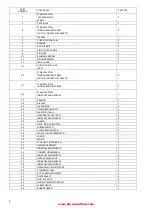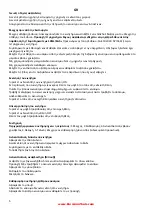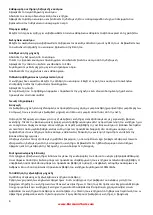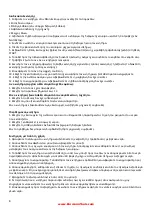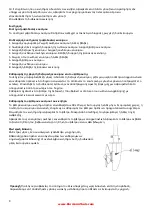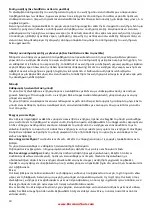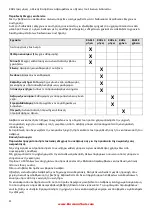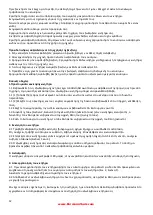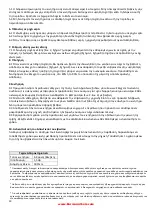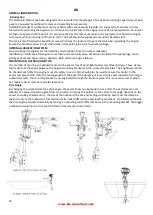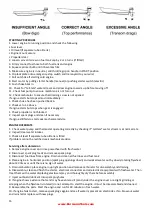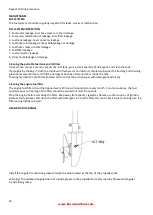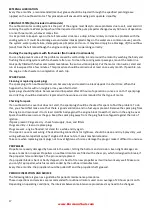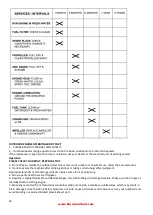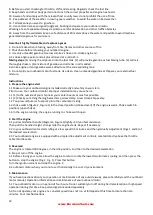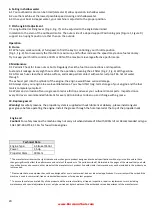
17
www.BormannTools.com
EXTERNAL LUBRICATION
Every three months, a recommended (marine) grease should be injected through the specified points (grease
nipples) on the outboard motor. This procedure will ensure all moving parts operate smoothly.
COOLING SYSTEM
(Not included in all models)
The outboard motor cooling system is the part of the engine most likely to cause problems due to salt, sand and dirt
entering the system. Water pumps should be inspected and the pump impeller changed every 50 hours of operation
or once three month, whatever comes first.
It is important to keep an eye on the tell tale water stream as a drop in flow is likely to indicate a problem with the
cooling system. It could be a blockage around water intakes (plastic bags in the water are a common cause), sand in
the system, water pump failure, damaged pump impeller and so on. It may also simply be a blockage of] the outflow
(sand) from the tell tale although the engine cooling system is operating correctly.
Flushing the cooling system with fresh water
(Not included in all models)
You can help prevent some of the problems caused by salt buildup in and around the
motor by washing the body and
flushing the cooling system with fresh water after
use. To clean the cooling water passages, mount the motor in a
tank partly filled with
fresh water (water level above the anti-cavitation plate). Put the motor into neutral,
start and
run at low speed for a few minutes. This procedure should be carried out at
least once every month. If possible, run
the engine in fresh water on completion of
each trip.
SPARK PLUGS
Cleaning or replacing spark plugs
The spark plugs of an outboard motor can become oily and coated in a black deposit in a short time. When this
happens the motor will run roughly or may even fail to start.
Spark plugs should therefore be removed and inspected after 20 hours of operation or once a month. If spark plugs
are dirty they should be cleaned or replaced with new ones as recommended for that type of motor.
Checking for spark
If an outboard turns over but does not start, the spark plug should be checked for spark to find the problem. To do
this, you should first make sure that there is good ventilation and no fuel vapor present. Remove the spark plug from
the engine and reconnect it to its lead. Hold its body against the engine block (to earth it) and turn the engine over.
Spark should be seen across the gap. Keep the spark plug away from the plug hole to safeguard against the risk of
ignition.
If spark present: Plugs are dry - check fuel supply, lines, and filters.
Plugs are dirty - clean or replace plugs
Plugs are wet - engine flooded, let stand for a while and try again
If no spark: Loose or wet wiring. Check all wiring connections for tightness, should be clean and dry. Spray dirty, wet
wiring with water-repellent spray. If engine still does not start, seek mechanical advice.
Take care when replacing spark plugs not to over tighten as this may damage the plug or make it difficult to unscrew.
PROPELLERS
Propellers are easily damaged by hazards in the water, hitting the bottom and corrosion. Even slight damage can
cause a reduction in speed. Propellers on outboard motors are fitted with a shear pin, which is designed to break, if
the propeller hits a solid object. The pin is easily replaced.
If a propeller blade is bent or badly chipped, it is best to fit a new propeller as it will not work very well. Make sure
you only fit a propeller, which is recommended by the outboard manufacturer.
Every three months, the propeller should be pulled off and the propeller shaft greased.
PERIODIC INSPECTION AND SERVICE
The following table is given as a guideline for periodic maintenance procedures.
These inspections and services are recommended for outboard motors used on an average of 20 hours per month.
Depending on operating conditions, the intervals between maintenance procedures may need to be changed.
Summary of Contents for GM1500
Page 3: ...3 www BormannTools com ...


